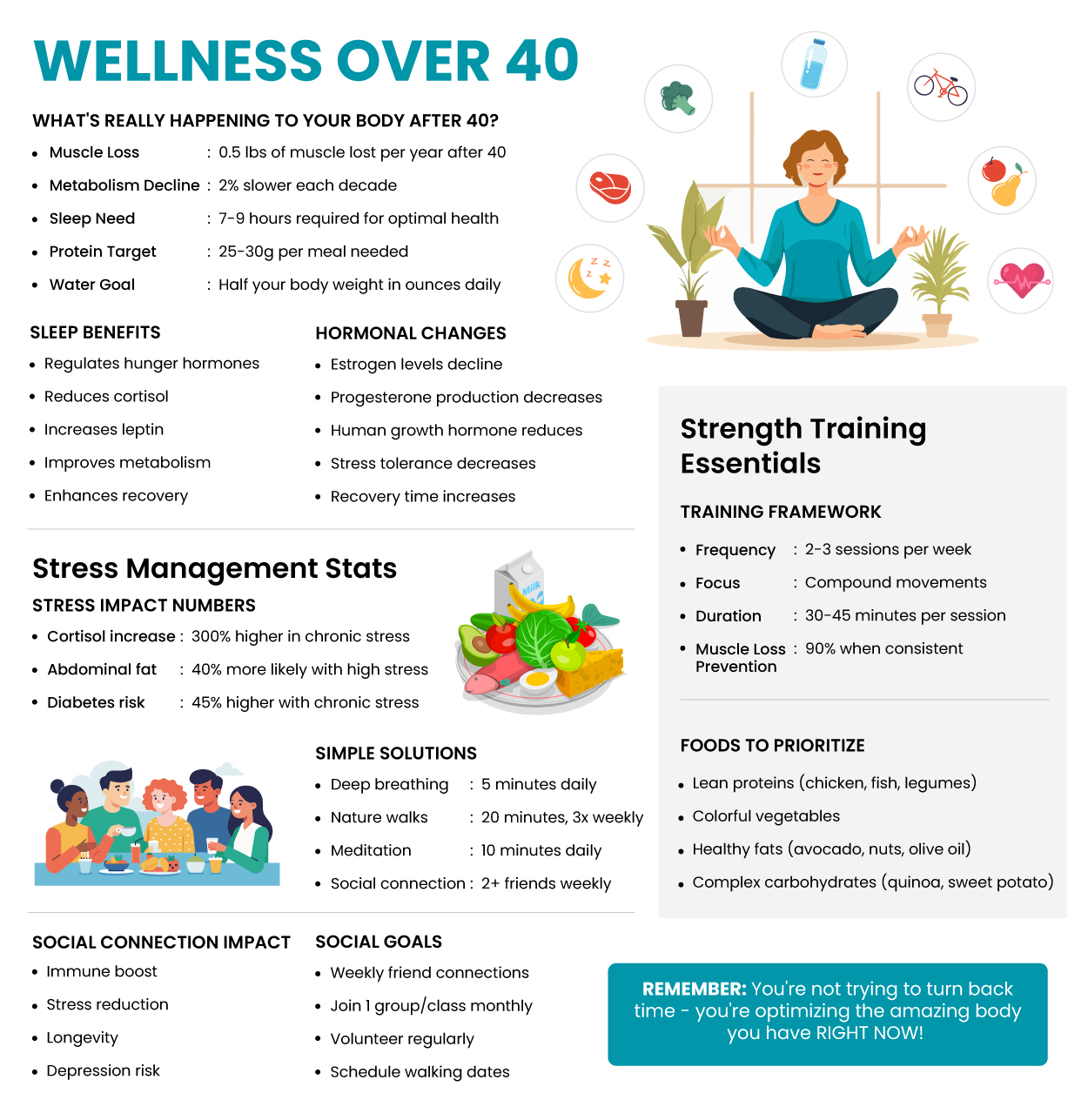“40 is the new 20” – you’ve probably heard this empowering phrase floating around social media, whispered in coffee shop conversations, or declared boldly by celebrities gracing magazine covers.
It’s absolutely true – but only if you’re willing to rewrite the rules of wellness over 40 and how you take care of yourself. Your body at 40 isn’t just an older version of your 20-year-old self; it’s an entirely different biology with its own unique needs, challenges, and incredible potential. While your twenty-something self could survive on pizza, three hours of sleep, and pure willpower, your fabulous-at-40 self requires a more sophisticated approach – one that honors the hormonal shifts, metabolic changes, and life wisdom you’ve gained along the way.
When you align your wellness habits with what your body actually needs now, not what worked decades ago, you feel younger and better than you ever have.
What’s Actually Happening After 40
Women lose about half a pound of muscle per year starting around age 40, while your metabolism slows down by 2% each decade. Meanwhile, estrogen, progesterone, and human growth hormone begin their gradual decline, creating a perfect storm of metabolic changes that can leave you feeling like a stranger in your own skin.
And it is not just your body, but your brain is also going through its own renovation project. You might find yourself standing in the kitchen wondering why you walked in there, feeling more emotionally sensitive than usual, or experiencing that frustrating “brain fog”. Sleep becomes more elusive just when you need it most, and stress, which you used to handle like a champion, suddenly feels overwhelming.
All that while society expects you to just power through all of this while looking effortlessly put-together, managing career peaks, possibly caring for aging parents, and perhaps dealing with teenagers who think you’ve lost your mind.
Here’s how you can fix all that.
Sleep Can be Your Ultimate Wellness Over 40 Weapon
Research consistently shows that poor sleep disrupts hormones that control hunger and metabolism. When you’re sleep-deprived, your body produces more cortisol (stress hormone) and less leptin (the hormone that tells you you’re full).
The sleep hygiene habits that make the biggest difference for wellness include keeping your bedroom cool (around 65-68°F), establishing a consistent bedtime routine, and yes, putting your phone in another room. Your Instagram feed will survive the night without you.
The Non-Negotiable Strength Training
Cardio alone won’t cut it for wellness over 40. Women on average will lose muscle mass twice as fast as men the same age, and muscle is what keeps your metabolism humming.
You don’t need to become a bodybuilder or spend hours in the gym. Two to three strength training sessions per week, focusing on compound movements like squats, deadlifts, and rows, can dramatically impact your wellness journey.
Nutrition to Focus On
The nutrition approach that supports wellness over 40 looks different from what worked in your younger years. Your body is now less forgiving of processed foods, sugar spikes, and meal skipping.
Protein becomes absolutely crucial and you should aim for 25-30 grams at each meal. Adequate protein will help maintain satiety, support hormone production, and keep your blood sugar stable. Eating breakfast every day is essential because it works together with your already-slowing metabolism.
Focus on whole foods, colorful vegetables, lean proteins, healthy fats like avocados and nuts, and complex carbohydrates that provide sustained energy rather than sugar crashes.
Stress Management
Metabolic changes in your body and shifts in its composition can increase abdominal fat, putting you at a higher risk of type 2 diabetes, and stress accelerates this process.
The most effective stress management doesn’t require expensive retreats or hour-long meditation sessions. Simple practices like deep breathing for five minutes daily, regular walks in nature, or even dancing in your kitchen while making dinner can significantly impact your stress hormones.
Small Habits, Big Results
Consistency is the key. Your body responds better to small, sustainable changes practiced regularly than dramatic overhauls that last three weeks.
Start with one habit like drinking a glass of water first thing in the morning. It could also be doing ten squats while your coffee brews or setting a consistent bedtime. Master one habit for a month before adding another.
The compound effect of these small changes over time is remarkable.
Hydration is a Must
Water intake becomes even more important for maintaining wellness over 40. Your body’s ability to recognize thirst decreases with age, and even mild dehydration can masquerade as fatigue, brain fog, or hunger.
Aim for half your body weight in ounces of water daily. If plain water bores you, add cucumber slices, lemon, or mint. Herbal teas count too. The goal is keeping your cells happy and your metabolism functioning optimally.
Movement Beyond Exercise
Take the stairs, park farther away, do calf raises while brushing your teeth, or have walking meetings.
This approach, called NEAT (Non-Exercise Activity Thermogenesis), can contribute significantly to your daily calorie burn and overall health. Plus, it’s much more sustainable than trying to cram all your movement into one intense hour at the gym.
The Social Connection Component
Isolation and loneliness can be as detrimental to health as smoking or obesity. Strong social connections boost immune function, reduce stress hormones, and even increase longevity.
Schedule regular coffee dates with friends, join a hiking group, take a cooking class, or volunteer for a cause you care about. Your wellness journey becomes much more enjoyable when you have people cheering you on.
Regular Health Monitoring
Part of smart wellness strategy involves staying ahead of potential health issues. Regular check-ups, blood work, and screenings appropriate for your age can catch problems early when they’re most treatable.
Don’t wait until something feels wrong. Prevention is always easier and cheaper than treatment. Work with your healthcare provider to establish a monitoring schedule that makes sense for your individual risk factors and family history.
The Mindset Shift
Perhaps most importantly, successful wellness over 40 requires releasing the comparison to your younger self. You cannot turn back the clock, but you sure can optimize the body you have now.
This means celebrating victories like sleeping through the night, having sustained energy throughout the day, or feeling strong and capable in your daily activities. These markers of health often matter more than the number on the scale.
Your Wellness Over 40 Action Plan
Start where you are, with what you have. Pick one area – sleep, nutrition, movement, or stress management and commit to one small improvement for the next 30 days. Once that becomes automatic, add another layer.
Remember, the goal is not perfection; it’s progress, feeling vibrant, energetic, and confident in your body at every stage of life. Your forties can absolutely be your most vital, healthy, and empowered decade yet.
Start today, be patient with the process, and trust that your body wants to feel good. You just need to give it the right tools to do so.
Frequently Asked Questions
- Is it really too late to start strength training at 40, and will I see results?
A: Absolutely not! It’s never too late to start strength training, and women over 40 actually respond incredibly well to resistance exercise. Starting at 40 gives you a huge advantage because you can prevent the typical muscle loss (0.5 pounds per year) and actually reverse some of the decline you may have already experienced. Most women notice improved energy and strength within the first month, with visible muscle definition appearing around 6-8 weeks.
- Why is losing weight so much harder after 40, even when I eat the same way I always have?
A: Your body’s metabolism naturally slows down by about 2% each decade after 30, and hormonal changes after 40 compound this effect significantly. Declining estrogen and progesterone levels affect how your body stores fat (particularly around the midsection) and processes carbohydrates. Focus on increasing protein intake to 25-30 grams per meal, incorporating strength training to preserve muscle, and consider meal timing – eating breakfast within 2 hours of waking helps kickstart your metabolism for the day.
- How much sleep do I really need at 40+, and what if I can’t seem to get quality rest?
A: Women over 40 need 7-9 hours of quality sleep per night, but the key word is “quality.” Poor sleep disrupts hormones that control hunger and metabolism, making weight management even more challenging. If you’re still struggling after 4-6 weeks of good sleep hygiene, speak with your healthcare provider about hormone testing or sleep studies.
- I feel stressed all the time and it’s affecting my health. What’s the connection between stress and wellness after 40?
A: Chronic stress becomes particularly problematic after 40 because your body’s ability to recover from stress decreases while life stressors often increase (career demands, aging parents, teenagers, etc.). High cortisol levels from chronic stress promote abdominal fat storage, disrupt sleep, suppress immune function, and can increase your risk of developing type 2 diabetes by up to 45%. But stress management doesn’t require hours of meditation. Simple practices like 5 minutes of daily deep breathing, regular walks in nature, maintaining social connections, and setting boundaries can significantly reduce cortisol levels.
- Do I need to completely overhaul my diet and lifestyle, or can small changes really make a difference?
A: Small, consistent changes are actually more effective than dramatic overhauls. Your body responds better to gradual adjustments that you can maintain long-term rather than extreme changes that lead to the “all or nothing” cycle. Research shows that people who focus on one habit at a time have a 90% success rate, while those who try to change multiple habits simultaneously have less than 10% success.








